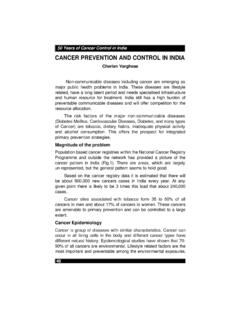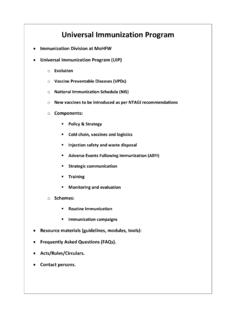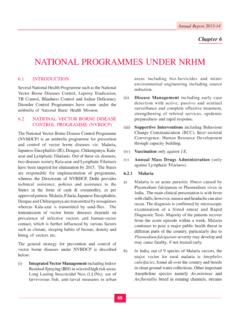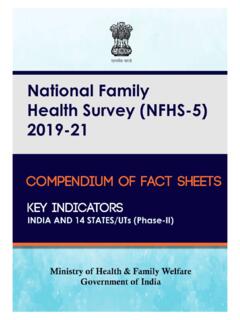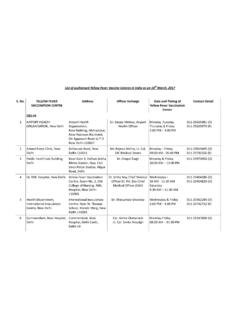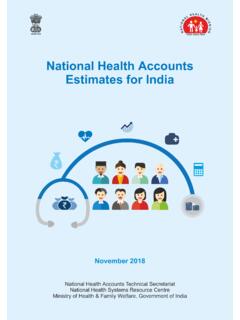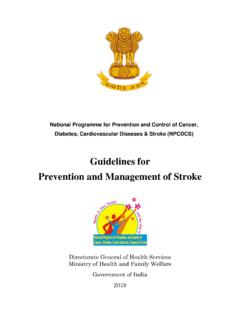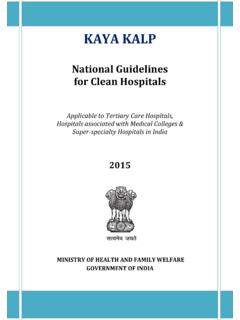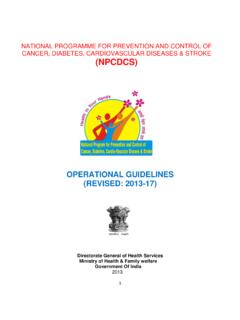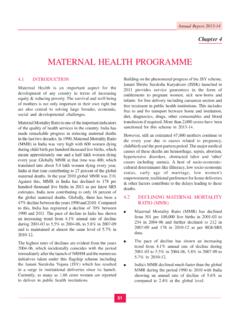Transcription of ELECTRONIC HEALTH RECORD - Ministry of Health and Family …
1 ELECTRONIC HEALTH RECORD (EHR) STANDARDS FOR INDIA2016 Standards Set Recommendations e- HEALTH Division Department of HEALTH & Family Welfare Ministry of HEALTH & Family Welfare Government of India TABLE OF CONTENTS Contents Executive Summary_____ 1 Standards at a Glance _____ 4 Standards and Interoperability _____ 8 HEALTH RECORD IT Standards _____ 10 Guidelines _____ 17 Data Ownership of HEALTH Records _____ 19 Data Privacy and Security _____ 24 Glossary _____ 29 Contact Information_____ 45 EXECUTIVE SUMMARY Page 1 Executive Summary INTRODUCTION In September 2013 the
2 Ministry of HEALTH & Family Welfare (MoH&FW) notified the ELECTRONIC HEALTH RECORD (EHR) Standards for India. The set of standards given therein were chosen from the best available and used standards applicable to ELECTRONIC HEALTH Records from around the world keeping in view their suitability to and applicability in India. The Committee constituted to recommend the standards drew from experts, practitioners, government officials, technologists, and industry. The notified standards were not only supported by professional bodies, regulatory bodies, stakeholders, but various technical and social commentators as well, as being a step in the right direction.
3 MoH&FW moved ahead with facilitating the adoption, as next steps, and in last two years the Ministry has made available standards like SNOMED CT free-for-use in the country as well as appoint interim National Release Center (NRC) to handle this clinical terminology standard that is fast gaining widespread acceptance amongst the various healthcare IT stakeholder communities worldwide. At the time of notifying the standards in September 2013, it was understood that the standards themselves will continue to evolve over time. Consequently, it was accepted that this notification will require revision from time to time.
4 This becomes all the more necessary as understanding of those standards, their implementation and the expectations from the healthcare systems improve. Hence, MoH&FW constituted an expert group to review the earlier notified set of standards based on the experience and with eyes firmly on the future. The set of standards provided herein represents the recommendations of the Expert Committee arrived at after deliberating on the various aspects of standardizations in healthcare RECORD systems. The Committee also carefully examined the provisions of open standards and the guidelines as per the norms suggested by MeitY, Government of India and recommended the standards given later in the document.
5 NEED FOR ELECTRONIC HEALTH RECORD For a HEALTH RECORD of an individual to be clinically meaningful it needs to be from conception or birth, at the very least. As one progresses through one s life, every RECORD of every clinical encounter represents a HEALTH -related event in one s life. Each of these records may be insignificant or significant depending on the current problems that the person is suffering from. Thus, it becomes imperative that these records be available, longitudinally arranged as a time series, and be clinically relevant to provide a summary of the various healthcare events in the life of a person.
6 An ELECTRONIC HEALTH RECORD (EHR) is a collection of various medical records that get generated during any clinical encounter or events. With rise of self-care and homecare devices and systems, nowadays meaningful healthcare data get generated 24x7 and also have long-term clinical relevance. The purpose of collecting medical records, as much as possible, are manifold better and evidence based care, increasingly accurate and faster diagnosis that translates into better treatment at lower costs of care, avoid repeating unnecessary investigations, robust analytics including predictive analytics to support personalized care, improved HEALTH EXECUTIVE SUMMARY Page 2 policy decisions based on better understanding of the underlying issues, etc.
7 , all translating into improved personal and public HEALTH . Without standards, a lifelong medical RECORD is simply not possible, as different records from different sources spread across ~80+ years, potentially, needs to be brought meaningfully together. To achieve this, a set of pre-defined standards for information capture, storage, retrieval, exchange, and analytics that includes images, clinical codes and data is imperative. STRATEGIC HIGHLIGHTS This document provides a structured overview of the key EHR standards with respect to Indian healthcare system. For every aspect of data/information that is part of any healthcare RECORD system has been addressed with a short guideline regarding implementation specific to the item-in-context included.
8 Various non-related recommendations from previous edition have been removed to better streamline the set of standards selected and achieve harmony among them. A detailed recommendation on the interoperability and standards, clinical informatics standards, data ownership, privacy and security aspects, and the various coding systems are also provided. The set of standards given in earlier edition has been updated with their latest versions as the country moves towards a better implementation. It would not be out of place to note that certain sections of the document have been removed to provide increased readability and consistency throughout while avoiding duplication, ambiguity and contradictions.
9 SCOPE This document provides a set of recommendations relevant to adoption of ELECTRONIC HEALTH informatics standards in EHR/EMR and other similar clinical information systems. The scope is limited to identifying the standards, their intended purposes in such systems, followed by a short guideline-for-implementation approach. It is understood that with adoption of these standards properly, the data capture, storage, view, presentation, and transmission will be standardized to levels that will achieve interoperability of both meaning and data contained in the records.
10 This document does not cater to wider implementation scenarios such as of administrative, legal or regulatory nature. This document also does not cater to aspects of creation and operation of local, regional or national infrastructures, indexes, or repositories as they are dealt with by appropriate regulative/administrative bodies. LOOKING AHEAD This document is a continuation of its earlier version, but in many ways reflects the growing confidence in the path correctly chosen earlier providing a set of international and proven standards with focus towards achieving syntactic and semantic interoperability of HEALTH records.
